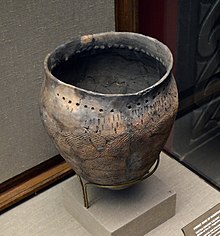| Alternative names | Textile Ceramic culture |
|---|---|
| Geographical range | Finland, northwestern Russia |
| Period | Bronze Age |
| Dates | 1900 BCE – 500 BCE |
| Preceded by | Volosovo culture, Fatyanovo–Balanovo culture |
The Netted Ware culture (also called Textile Ceramic culture) was a Bronze Age culture in northeastern Europe that extended from Finland to the upper Volga region in Russia. [1] [2]

The Netted Ware culture emerged around 1900 BCE with the arrival of the Seima-Turbino phenomenon in the upper Volga region, replacing the earlier Fatyanovo–Balanovo and Volosovo cultures, and soon expanded to the west to Karelia and eastern and central Finland. [2] The Netted Ware culture did not reach southwestern Finland, the area of the Kiukainen culture and later the Nordic Bronze culture. [1] The subsistence of the Netted Ware culture was based on small-scale swidden agriculture and animal husbandry. [2] [3]
The spread of the Netted Ware culture has been linked to the dispersal of early forms of the Finno-Volgaic languages, especially Finnic languages and Saami languages. [2] [3]
- ^ a b Carpelan, Christian; Parpola, Asko (2001). "Emergence, contacts and dispersal of Proto-Indo-European, Proto-Uralic and Proto-Aryan in archaeological perspective". In Christian Carpelan; Asko Parpola; Petteri Koskikalli (eds.). Early contacts between Uralic and Indo-European: Linguistic and archaeological considerations (PDF). Mémoires de la Société Finno-Ougrienne 242. Helsinki: Société Finno Ougrienne. pp. 55–150. Retrieved 7 Dec 2022.
- ^ a b c d Parpola, Asko (2017). "Finnish vatsa – Sanskrit vatsá – and the formation of Indo-Iranian and Uralic languages". Journal de la Société Finno-Ougrienne. 2017 (96). doi: 10.33340/susa.70229. hdl: 10138/311944.
- ^ a b Nichols, Johanna (2021). "The Origin and Dispersal of Uralic: Distributional Typological View". Annual Review of Linguistics. 7 (1): 351–369. doi: 10.1146/annurev-linguistics-011619-030405.
| Alternative names | Textile Ceramic culture |
|---|---|
| Geographical range | Finland, northwestern Russia |
| Period | Bronze Age |
| Dates | 1900 BCE – 500 BCE |
| Preceded by | Volosovo culture, Fatyanovo–Balanovo culture |
The Netted Ware culture (also called Textile Ceramic culture) was a Bronze Age culture in northeastern Europe that extended from Finland to the upper Volga region in Russia. [1] [2]

The Netted Ware culture emerged around 1900 BCE with the arrival of the Seima-Turbino phenomenon in the upper Volga region, replacing the earlier Fatyanovo–Balanovo and Volosovo cultures, and soon expanded to the west to Karelia and eastern and central Finland. [2] The Netted Ware culture did not reach southwestern Finland, the area of the Kiukainen culture and later the Nordic Bronze culture. [1] The subsistence of the Netted Ware culture was based on small-scale swidden agriculture and animal husbandry. [2] [3]
The spread of the Netted Ware culture has been linked to the dispersal of early forms of the Finno-Volgaic languages, especially Finnic languages and Saami languages. [2] [3]
- ^ a b Carpelan, Christian; Parpola, Asko (2001). "Emergence, contacts and dispersal of Proto-Indo-European, Proto-Uralic and Proto-Aryan in archaeological perspective". In Christian Carpelan; Asko Parpola; Petteri Koskikalli (eds.). Early contacts between Uralic and Indo-European: Linguistic and archaeological considerations (PDF). Mémoires de la Société Finno-Ougrienne 242. Helsinki: Société Finno Ougrienne. pp. 55–150. Retrieved 7 Dec 2022.
- ^ a b c d Parpola, Asko (2017). "Finnish vatsa – Sanskrit vatsá – and the formation of Indo-Iranian and Uralic languages". Journal de la Société Finno-Ougrienne. 2017 (96). doi: 10.33340/susa.70229. hdl: 10138/311944.
- ^ a b Nichols, Johanna (2021). "The Origin and Dispersal of Uralic: Distributional Typological View". Annual Review of Linguistics. 7 (1): 351–369. doi: 10.1146/annurev-linguistics-011619-030405.